E was already 26 when he enlisted in the IDF. Before that, he studied full time at the Ateret Cohanim Yeshiva in Jerusalem’s Old City. He was married and a father, and he was ready to do his military service.
He insisted on a combat unit. “I wanted to do something significant,” he said. He became a tank crewman.
Many military pundits have declared tanks obsolete for modern warfare. They say that armored personnel carriers and drones are more effective instrument of war. Even in Israel, with our glorious history of Armored Corps successes, the number of tank regiments has been greatly reduced.
E was happy to serve in a tank.
There are four soldiers in an Israeli tank: the commander, the driver, the gunner, and the loader. E, who is slim and of average height, became a gunner.
The excellent performance of tank crews in Gaza challenges the obsolescence of the tank. Our Israeli Merkava Mark IV tank has active protective systems and other hi-tech features, with tiny radars and fast-firing grenade launchers that automatically detect incoming missiles and rockets and intercept them. The tanks have reportedly also been fitted with low-tech but effective metal covers that protect them from Hamas quadcopter drones.
Life and friendship inside IDF tanks
Even though tanks are considered better for distance than close-range fighting, the tank crews have been performing with success and valor in Gaza’s tight spaces.
To write this column, as you may already have guessed, I’ve been watching tank videos and reading personal descriptions of life inside tanks. The diarists from different countries have similar complaints of chronic discomfort, ultimate lack of privacy, and a dearth of downtime. In spare moments, there is often something that needs fixing in the giant metal machine. The tankers recall the din, the sweat, and the shared odors. But they also hail the unmatched camaraderie that develops among the crew. No one whose story I read mentioned fear, although even the most sophisticated tanks are not impenetrable.
On October 7, reports of the attack in the South filtered into the synagogue where E went to pray. Like many of his bench mates, devout yeshiva student E ran home to retrieve his phone. He wasn’t surprised to be called up, but he was disappointed that his initial posting was on the northern border. After many requests, E was transferred to Gaza.
Looking back, E’s wife, Ori – a young woman who can only be described as beautiful – said she was actually happy for him to get a place in a tank in Gaza because he was so miserable not serving at the front. She coped alone in their home in the Old City with their three children under age four, pregnant with their fourth.
Nonetheless, when the Swords of Iron ceasefire was called to allow a hostage exchange, she had come close enough to the end of term that she asked to be induced so E could be home for the birth.
With their newborn daughter curled up in her cradle, E returned to the battlefield. Now he would join a different tank crew. His previous tank was a command tank, and the constant flow of radio information made talking difficult. But in the new tank, there was time to talk. About everything. He soon learned that the loader, whose compartment abutted his own gunner’s space in the turret basket, was a yeshiva student like him. The commander was an opinionated far-leftist. The driver, who had grown up in a religious home, was now anti-religious.
On December 11, their Merkava IV tank was dispatched from the line to rescue another tank that had slipped into one of the ubiquitous pits created by the airstrikes. After the crew members had completed their tasks, on the way back to the line a terrorist crawled out of a tunnel opening and at close range shot an anti-tank missile at them.
Inside, E felt the enormous jolt.
“The driver was going fast, which was good. The belly of a tank is its weak spot. The RPG hit the rear of the tank, and not the middle. Had it hit the middle, we would have been killed,” E said.
The commander started to get out, but then realized he might be a target for a sniper. He fell off the fast-moving tank and managed to press himself to the earth as the giant wheels straddled him.
The ammunition carried in their tank began to burn from the hit. The turret where E, the gunner, and the loader were sitting became excruciatingly hot and full of noxious smoke. The force of the blast knocked the loader to the rear exit of the tank (an unusual feature of the Merkava). The driver managed to get out.
E was alone in the turret, unconscious.
Help was nearby – no tank travels on its own. Four or five men tried to lift E out. Each one vomited and fainted before he could complete the task.
Inside, E was literally burning. His lungs were filling with smoke.
At last, a very tall soldier managed to lift E out while keeping his head outside the tank.
“It was a miracle that I was alive,” E says today. “I lost consciousness so quickly, that I couldn’t even say ‘Shema Yisrael.’”
The commander under the tank was moderately wounded. The driver managed to get out with light wounds. The loader was severely wounded and is now waiting for a lung transplant. E was burned over most of his body.
WHEN I first saw E at Hadassah-University Medical Center, in Jerusalem’s Ein Kerem, he was having skin grafts and treatment for lung damage. The skin on his face was a mask of dark swirls and bubbles. He was startling to look at, at first, but he was always so welcoming and uncomplaining that I stopped noticing how he looked.
He’s still in rehab. We often meet in Hadassah’s Gandel Rehabilitation Center, where he’s working hard to get back his lung capacity and is still healing from his burns. Mostly, we talk about the bonding within the tank: how two devout yeshiva students; one man hostile to religion; and the fourth indifferent to religion and espousing liberal political and societal views often an anathema to E could talk about everything.
Inside the thick metal walls of the tank, with the enemy stalking them outside, they could argue and shout and laugh without the slightest risk of upsetting the cohesion of a single, determined fighting force or endangering their shared brotherly love and loyalty.
And we wonder how we can make that camaraderie part of the healing process for our nation. Let’s start at our Passover Seder tables.
The writer is the Israel director of public relations at Hadassah, the Women’s Zionist Organization of America. Her latest book is A Daughter of Many Mothers.

